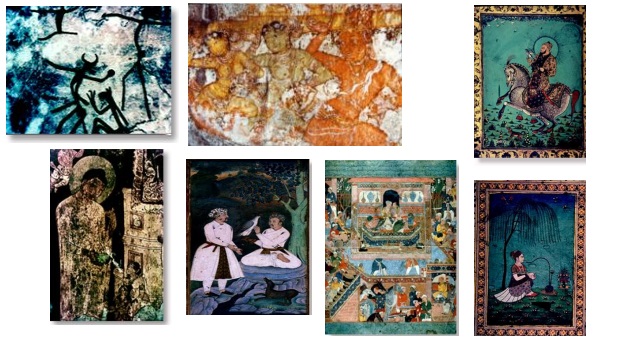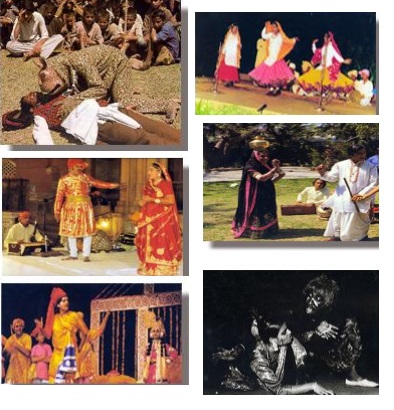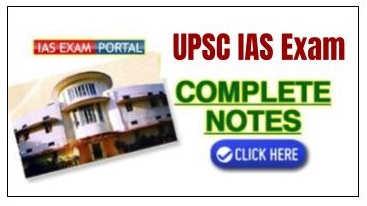General Knowledge for IAS Exams (PAINTINGS OF INDIA)
A) WALL PAINTINGS OF INDIA
Painting - expresses human thoughts and feelings through the media of line and colour.
METHOD OF PAINTINGS
1)True Fresco Method- the paintings are done when the surface wall is still wet so that the pigments go deep inside the wall surface.
2)Tempora or Fresco-Secco- method of painting on the lime plastered surface which has been allowed to dry first and then drenched with fresh lime water.
Cave dweller
- painted rock shelters to satisfy his aesthetic sensitivity and creative urge
- primitive records of wild animals, war processions, birds & marine creatures
- human images, dancing images and hunting scenes.
- Bhimbetka caves in the Kaimur Range, MP.
AJANTA CAVE PAINTING:-
- exclusively Buddhist, excepting decorative patterns on the ceilings and the pillars.
- associated with the Jatakas, recording the previous births of the Lord Buddha.
- Principal characters in most of the designs are in heroic proportions.
ELLORA CAVE PAINTING:-
- out in rectangular panels with thick borders.
- most important characteristic features
- sharp twist of the head,
- painted angular bents of the arms,
- concave curve of the close limbs,
- sharp projected nose and
- long drawn open eyes
WALL PAINTINGS IN SOUTH INDIA
- Tanjore, Tamil Nadu
- wide open eyes of all the figures as compared to Ajanta tradition of half closed drooping eyes
- dancing girl from Brihadeshwara temple of Tanjore

B)MINIATURE PAINTING
THE MUGHAL SCHOOL (1560-1800 A.D.)
- synthesis of the indigenous Indian style of painting and the Safavid school of Persian painting.
- marked by supple naturalism
- based on close observation of nature and fine and delicate drawing.
- high aesthetic merit.
- primarily aristocratic and secular.
- Tuti-nama - first work of the Mughal School.
- Hamza-nama( illustrations on cloth)- more developed and refined than Tutinama.
- Under Jahangir, painting acquired greater charm, refinement and dignity.
- Under Shah Jahan - painting maintained its fine quality.
- Under Aurangzeb- Painting declined and lost much of its earlier quality.
THE DECCANI SCHOOLS (CIRCA 1560-1800 A.D.)
1. AHMEDNAGAR
- female appearing in the painting belongs to the northern tradition of Malwa.
- Choli (bodice) and long pigtails braided and ending in a tassel are the northern costume.
- colours used are rich and brilliant
- Persian influence - high horizon, gold sky and the landscape.
2. BIJAPUR
- ladies - tall and slender and are wearing the South Indian dress.
- rich colour scheme, the palm trees, animals and men and women all belongs to the Deccani tradition.
- profuse use of gold colour
- some flowering plants and arabesques on the top of the throne are derived from the Persian tradition.
3. GOLCONDA
- "Lady with the Myna bird", about 1605 A.D
- colours are rich and brilliant
- continued long after the extinction of the Deccan Sultanates of Ahmednagar,Bijapur and Golconda.
4. HYDERABAD
- belongs to the third quarter of the 18th century.
- introduced by several Mughal painters who migrated to the Deccan during the period of Aurangzeb and sought patronage there.
- Distinctive features - treatment of the ethnic types, costumes, jewellery, flora,fauna, landscape and colours.
- style of the painting is decorative.
- typical characteristics - rich colours, the Deccani facial types and costumes
5. TANJORE
- works on cloth stretched over wood.
- style of painting - bold drawing, techniques of shading and the use of pure and brilliant colours
- flourished during the late 18th and 19th centuries.
- style is decorative and is marked by the use of bright colours and ornamental details.
- conical crown - a typical feature of the Tanjore painting.
6. MYSORE
- more subtle and done on paper, while the Tanjore works on cloth stretched over wood.
- deal mostly with sacred icons painted for devotional purposes.
- theatrical framing of the iconic paintings should be particularly noted.
RAJASTHANI AND CENTRAL INDIAN SCHOOLS (17TH-19TH CENTURIES)
- deeply rooted in the Indian traditions, taking inspiration from Indian epics, Puranas, love poems & Indian folk-lore.
- Mughal artists of inferior merit who were no longer required by the Mughal Emperors, migrated to Rajasthan
- Rajasthani style - bold drawing, strong and contrasting colours.
- treatment of figures is flat without any attempt to show perspective in a naturalistic manner.
- surface of the painting is divided into several compartments of different colours in order to separate one scene from another.
- each school of painting has its distinct facial type, costume, landscape and colour scheme.
1. MALWA
- use of contrasting colours, refinement of drawing due to the influence of the Mughal painting
- ornaments and costumes consisting of black tassels and striped skirts.
2. MEWAR
- drawing is bold and the colours are bright and contrasting.
- text of the painting is written in black on the top against the yellow ground.
3. BUNDI
- very close to the Mewar style
- rich and glowing colours, the rising sun in golden colour, crimson-red horizon,overlapping and semi-naturalistic trees
- Mughal influence is visible in the refined drawing of the faces
4. KOTAH
- very much akin to the Bundi style
- Themes of tiger and bear hunt were very popular at Kotah.
- most of the space is occupied by the hilly jungle which has been rendered with a unique charm.
5. AMBER – JAIPUR
- this school of painting originated at Amber but later shifted to Jaipur, the new capital.
- There is a fairly large number of portraits of the Jaipur rulers
6. MARWAR
- executed in a primitive and vigorous folk style
- completely uninfluenced by the Mughal style.
- A large number of miniatures comprising portraits, court scenes, series of the Ragamala and the Baramasa, etc. were executed from the 17th to 19th centuries at several centres of painting like Pali, Jodhpur and Nagour etc. in Marwar.
7. BIKANER
- Bikaner had close relations with the Mughals.
- Some of the Mughal artists were given patronage by the Bikaner court
- responsible for the introduction of a new style of painting having much similarity with the Mughal and the Deccani styles.
8. KISHENGARH
- developed under the patronage of Raja Savant Singh (1748-1757 A.D.) , who wrote devotional poetry in praise of Krishna
- master painter Nihal Chand who, in his works, has been able to create visual images of his master's lyrical compositions
PAHARI SCHOOL (17TH TO 19TH CENTURIES)
- comprises the present State of Himachal Pradesh, some adjoining areas of the Punjab, Jammu and Garhwal in UP.
- this area was ruled by the Rajput princes and were often engaged in welfare.
- centres of great artistic activity from the latter half of the 17th to nearly the middle of the 19th century.
1.BASOHLI
- characterised by vigorous and bold line and strong glowing colours.
- There is a change in the facial type which becomes a little heavier and also in the tree forms which assume a somewhat naturalistic character, which may be due to the influence of the Mughal painting.
- general features - use of strong and contrasting colours, monochrome background, large eyes, bold drawing, use of beetles wings for showing diamonds in ornaments, narrow sky and the red
2.GULER (Jammu)
- consisting of portraits of Raja Balwant Singh of Jasrota (a small place near Jammu) by Master Nainsukh.
- He worked both at Jasrota and at Guler.
- paintings are in a new naturalistic and delicate style marking a change from the earlier traditions of the Basohli art.
- colours used are soft and cool.
- inspired by the naturalistic style of the Mughal painting.
3.KANGRA
- third phase of the Pahari painting in the last quarter of the 18th century.
- developed out of the Guler style.
- the faces of women in profile have the nose almost in line with the forehead, the eyes are long and narrow and the chin is sharp.
- There is, however, no modelling of figures and hair is treated as a flat mass.
4.KULU – MANDl
- a folk style of painting, mainly inspired by the local tradition.
- style is marked by bold drawing and the use of dark and dull colours.
- Though influence of the Kangra style is observed in certain cases yet the style maintains its distinct folkish character.
INDEPENDENT PAINTINGS
1.KALIGHAT PAINTINGS- KOLKATTA
- Kalighat painting was a product of the changing urban society of the nineteenth century Calcutta.
- group of artists evolved a quick method of painting on mill-made paper. Using brush and ink from the lampblack, these artists defined figures of deities, gentry and ordinary people with deft and vigorously flowing lines.
- romantic depictions of women.
- satirical paintings lampooning the hypocrisies of the newly rich and the changing roles of men and women after the introduction of education for women.
2.MADHUBANI PAINTINGS- MITHILA,BIHAR
- Women (Mithila region,Bihar) have painted colorful auspicious images on the interior walls of their homes on the occasion of domestic rituals since at least the 14th century.
- This ancient tradition, especially elaborated for marriages, continues today.
- used to paint the walls of room, known as KOHBAR GHAR in which the newly wedded couple meet for the first time.
3.PHAD: SCROLL PAINTINGS (BHILWADA, RAJASTHAN)
- Phad is a painted scroll, which depicts stories of epic dimensions about local deities and legendary heroes.
- Bhopas(local priests) carry these scrolls on their shoulders from village to village for a performance
- represents the moving shrine of the deity and is an object of worship.
- most popular and largest Phad belong to local deities Devnarayanji and Pabuji.
4.KALAMKARI PAINTINGS (ANDHRA PRADESH)
- Kalamkari (lit. pen-work) is primarily used for the temple festivals or as wall hangings.
- stories from the epics Ramayana, Mahabharata and the Puranas are painted as continuous narratives
- relevant Telugu verses explaining the theme are also carried below the artwork.
- colors are obtained from vegetable and mineral sources.
- gods are painted blue,
- the demons and evil characters in red and green.
- Yellow is used for female figures and ornaments.
- Red is mostly used as a background.
5.KOLAM
- Kolam is a ritualistic design drawn at the threshold of households and temples.
- drawn everyday at dawn and dusk by women in South India
- Kolam marks festivals, seasons and important events in a woman's life such as birth, first menstruation and marriage.
- Kolam is a free-hand drawing with symmetrical and neat geometrical patterns.









